Mike:Draft Text on Method: Difference between revisions
No edit summary |
No edit summary |
||
| Line 1: | Line 1: | ||
'''Ragdoll physics on animated human figures:''' <br/> | |||
[[File:Mike ragdoll.png|600px]]<br/> | [[File:Mike ragdoll.png|600px]]<br/> | ||
https://www.youtube.com/edit?o=U&video_id=0KGyrfy4gtc<br/> | https://www.youtube.com/edit?o=U&video_id=0KGyrfy4gtc<br/> | ||
'''Cloth physics on animated human figures:''' <br/> | |||
[[File:Mike_cloth_01.png|600px]] | |||
[[File:Mike_cloth_02.png|600px]] | |||
[[File:Mike_cloth_03.png|600px]] | |||
[[File:Mike_cloth_05.png|600px]] | |||
[[File:Mike_cloth_06.png|600px]] | |||
[[File:Mike_cloth_07.png|600px]]<br/> | |||
https://www.youtube.com/watch?v=3K_BnH7Ypro <br/> | https://www.youtube.com/watch?v=3K_BnH7Ypro <br/> | ||
https://youtu.be/JHKCwTofSYM <br/> | https://youtu.be/JHKCwTofSYM <br/> | ||
| Line 20: | Line 16: | ||
https://youtu.be/8mBWUu8vmqk <br/> | https://youtu.be/8mBWUu8vmqk <br/> | ||
https://youtu.be/qLI7sK-3DnU <br/> | https://youtu.be/qLI7sK-3DnU <br/> | ||
== Collected Notes: == | |||
The film came to be through an ongoing fascination in the ways that physical forms are translated and transformed into the digital realm. I have an interest in how 3d animation technologies are often highly focused on the “accurate” depiction of real-world phenomena. 3d scanning in particular is often presented as way of achieving maximum realism in 3d graphics. In this animation I was focused on how 3d models are essentially shells, rather than physical forms that have volume. By having the forms repeatedly collapse upon themselves, the hollowness of the digital source material can be revealed. | |||
This animation combines my interest of contemporary technological forms with the more classical form of still life painting. What attracts me to still life paintings is how the paintings can study the form of their subject but also reveal much about how they are made. The quality and materiality of paint exist on equal footing with the study of light, color and form. I took inspiration from the term of Still Life itself, by focusing on the idea of stillness. I also took inspiration from how the term is expressed in French as “Nature Morte,” which can be literally translated to dead nature. In this animation the stillness, unnaturalness and deadness of these virtual objects becomes the focus of the piece. | |||
An ongoing area of interest is how many moments and many perspectives can be combined into a single image. I was interested in seeing how to achieve this type of composite image through analogue means. (A side area of interest is how this technique is an early form a 3d scanning. When combined with a turntable, archaeologists would use this technique to unwrap imagery on the surface ceramic vases etc.) | |||
he concept of the book was to create a sort of false photo book, mediated through multiple layers of technology. Rather than being a single snapshot from a single camera, the models are scanned with dozens of cameras all taking a picture from as many angles as possible all at once. The lighting is generated from 360 degree panoramic images, also sourced from stock collections. The panoramic images also captured by a camera taking a multiple photos from multiple angles to capture an entire panorama, and from multiple exposures to capture the maximum amount light information. The final photograph is captured through a virtual camera in the 3d software, using a shallow depth of field effect. The end result is mundane snapshots, that are in fact complex composite images that required many cameras, many photographers and many layers of software to be achieved. | |||
As all of the materials featured inside book were sourced from collections on the internet, the books were printed using online printing services as a way of closing the loop from source to outcome. | |||
With this most recent project I made the choice to consider the subject matter before embarking on the project and have the subject matter reference something happening in the real world that has a political and social edge to it. | |||
My work in the past has mostly focused in a self-reflexive about the qualities of the medium in which it is made. This means animations about animation, animations about animation technology, animations about technology. While I don’t think I’ve totally exhausted that line of inquiry, I felt it useful (especially in the context of this study program) to experiment and engage with more subject matter. | |||
In the past I have struggled to talk and write about the ideas behind my works, with this project I tried to impose some concrete subject matter to make it easier to talk and write about my work when the project is finished. | |||
I also made the decision to adjust the formal qualities of the work. Earlier works almost always used static cameras and locked-off shots, extreme color palettes and solid color backdrops. I decided to explore a more photo-realistic approach, a muted color palette and more dynamic camera movements. I chose this approach in part to break out of old habits, but also because it did not suit the subject matter. If the overall color palette was too bright and colourful it might limit the emotional impact of the piece. | |||
In doing research for this current project I have been revisiting the work of Matthew Barney after not directly engaging with his work for over a decade. I was specifically interested in the way that special effects and automobiles play into his work. | |||
In Cremaster 3 this an extended scene set in a recreation in the lobby of the Chrysler building where several cars back into an older black 1920’s car in a ritualistic fashion until the black car is compressed an obliterated. | |||
The user within these cloud platforms occupies a contradictory position.Bratton uses the example of the Silicon Valley obsession with the quantified self, using data as a means of knowing and having mastery of the self. In becoming a data stream, he also has to acknowledge the outside data streams that act on him. Where he begins and where he ends in this flow of data starts blur. The blurring continues beyond actual individuals, into proxy users (users acting on other user’s behalf, crossing phyislcal borders, bypassing restrictions in one location by appearing in another) . This expands even further adding in non-human users such as sensors, algorithms and robots. This ends up in a position where the user is not only an individual but also a composite and an aggregate of other users, both human and non-human. What looks like one is really many, what looks like many may only be one with paranoia and narcissism as two symptoms of the same disposition. | |||
“First over individuated then multiplied and de-differientiated | |||
What are the limits of this approach regarding data | |||
Can only talk about the conditions of its production | |||
How does this relate to my own work, previous : | |||
In my previous and ongoing work, often deals with the human form as a streams of data, | |||
As systems of information | |||
Repurposable containers of data, | |||
The point where I find connection in Bratton’s essay, is in his articulation of the user. | |||
The user’s position within the stack, shifts from that of the individual and human, | |||
to the plural and the many and then beyond into the non-human and algorithmic | |||
“Artificial over-individuation and […] ultimate pluralisation” | |||
“Like Theseus’s Paradox—where after every component of a thing has been replaced, nothing original remains but a metaphysical husk—the User is confronted with the existential lesson that at any point he is only the intersection of many streams. At first, the subject position of the User overproduces individual identity, but in the continuance of the same mechanisms, it then succeeds in exploding it.” | |||
The characters that appear in my animations are composites | |||
They are an amalgam of different sources and different times, different recordings, different actors or drivers, | |||
Sourced from real people, recorded at different times often combined into one | |||
A series of engineering decisions, constraints that artificial, practical, arbitrary, conforming to physical or technical parameters | |||
The form is changeable as it is creative tool, it should be adjusted to suit the needs of whomever is using it. | |||
But in order to be changeable, adjustable, the form needs to be set to an adaptable state, | |||
Reduced to its most basic, prototypic, archetypal, | |||
What is retained, what remains of the individual | |||
What happens when it is reformed and recomposed | |||
How does this change in my new work: | |||
Roland Bathes | |||
"I think that cars today are almost the exact equivalent of the great Gothic cathedrals: I mean the supreme creation of an era, conceived with passion by unknown artists, and consumed in image if not in usage by a whole population which appropriates them as a purely magical object." | |||
-Roland Barthes mythologies | |||
Sontag | |||
The “realistic” view of the world compatible with bureaucracy redefines knowledge—as techniques and information.Photographs are valued because they give information. They tellone what there is; they make an inventory. To spies,meteorologists, coroners, archaeologists, and other information professionals, their value is inestimable. But in the situations in which most people use photographs, their value as information is of the same order as fiction. The information that photographs can give starts to seem very important at that moment in cultura l history when everyone is thought to have a right to something called news. | |||
Flusser | |||
Technical images, for their part, are third-degree abstractions; they are abstracted from texts, which in turn are abstracted from images which were themselves abstracted from the concrete world. Again historically,traditional images may be called "pre-historical," while technical images may be called "post-historical," in the sense suggested previously. Ontologically, traditiona l images mean phenomena, while technical images mean concepts. Deciphering technical images implies a reading of their position. | |||
Sontag | |||
Much of modern art is devoted to lowering the threshold of what is terrible. By getting us used to what, formerly, we could not bear to see or hear, because it was too shocking, painful, or embarrassing, art changes morals—that body of psychic custom and public sanctions that draws a vague boundary between what is emotionally and spontaneously intolerable and what is not. | |||
Surrealism lies at the heart of the photographic enterprise: in the very creation of a duplicate world, of a reality in the second degree, narrower but more dramatic than the one perceived by natural vision. Theless doctored, the less patently crafted, the more naive—the more authoritative the photograph was likely to be. | |||
“The grotesques were not all horrible. Some were amusing, some almost beautiful....”Surrealism is the art of generalizing the grotesque and then discovering nuances (and charms) in that. No activity is betterequipped to exercise the Surrealist way of looking than photography, and eventually we look at all photographs surrealistically. People are ransacking their attics and the archives of city and state historical societies for old photographs; ever more obscure or forgotten photographers are being rediscovered. | |||
The Surrealist strategy, which promised a new and exciting vantage point for the radical criticism of modern culture, has devolved into an easy irony that democratizes all evidence, that equates its scatter of evidence with history. Surrealism can only deliver a reactionary judgment; can make out of history only an accumulation of oddities, a joke, a death trip. | |||
*The restriction of photography to impersonal seeing has of course continued to have its advocates. Among the Surrealists, photography was thought to be liberating to the extent that it transcended mere personal expression: Breton starts his essay of 1920 on Max Ernst by calling the practice of automatic writing “a true photography of thought,” the camera being regarded as “a blind instrument” whose superiority in “the imitation of appearances” had “dealt a mortal blow to the old modes of expression, inpainting as well as poetry.” In the opposing aesthetic camp, the Bauhaus theoreticians took a not dissimilar view, treating photography as a branch of design, like architecture—creative but impersonal, unencumbered by such vanities as the painterly surface,the personal touch. In his book Painting, Photography, Film (1925) Moholy-Nagy praises the camera for imposing “the hygiene of the optical,” which will eventually“abolish that pictorial and imaginative association pattern...which has been stamped upon our vision by great individual painters.” | |||
� | |||
Revision as of 16:04, 9 May 2018
Ragdoll physics on animated human figures:
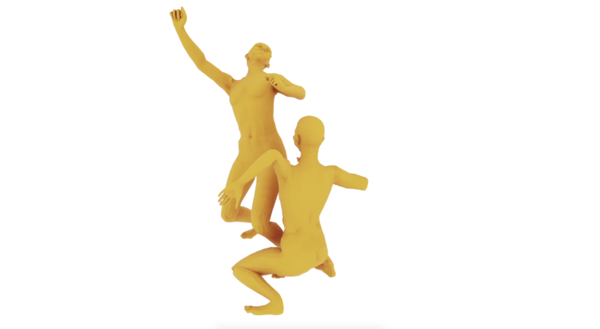
https://www.youtube.com/edit?o=U&video_id=0KGyrfy4gtc
Cloth physics on animated human figures:
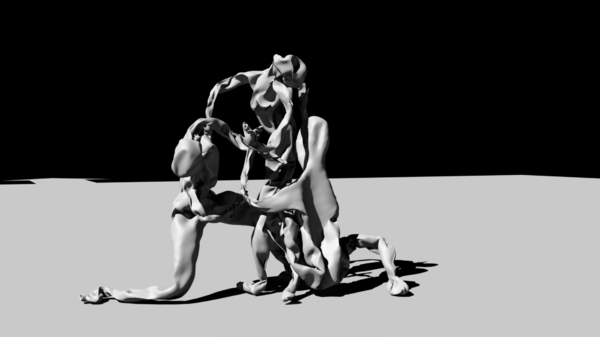
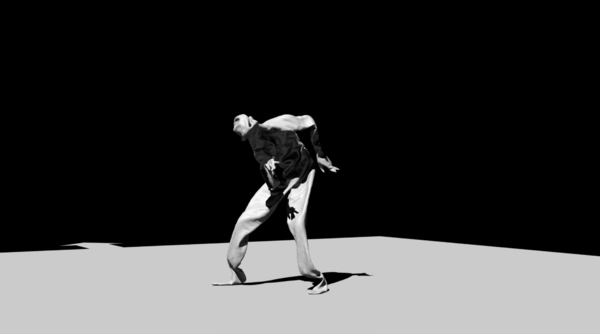
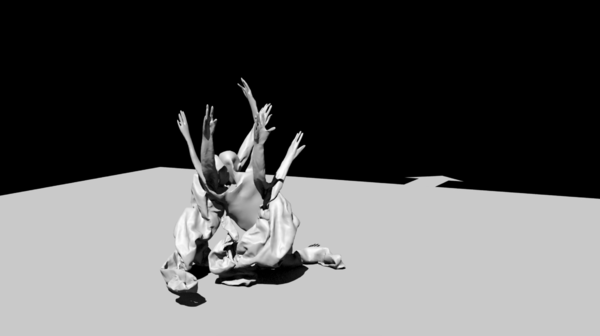
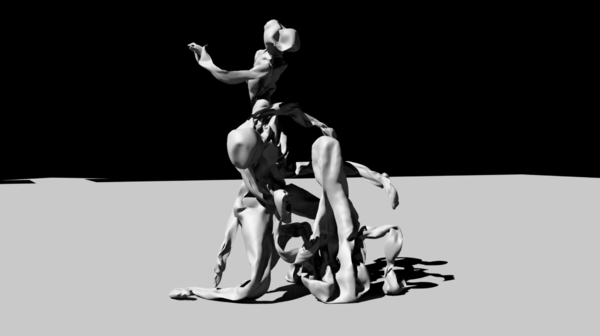
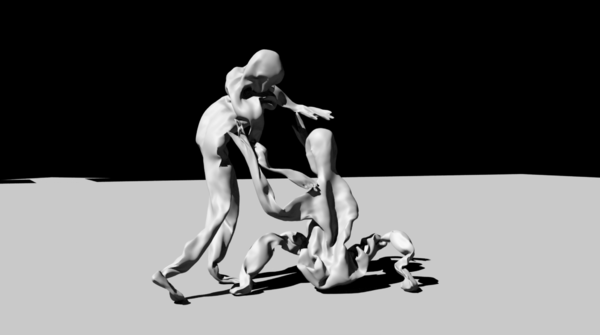
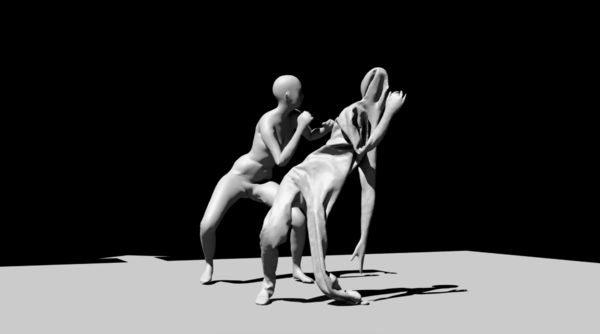
https://www.youtube.com/watch?v=3K_BnH7Ypro
https://youtu.be/JHKCwTofSYM
https://youtu.be/Bvl4eJoKVXA
https://youtu.be/8mBWUu8vmqk
https://youtu.be/qLI7sK-3DnU
Collected Notes:
The film came to be through an ongoing fascination in the ways that physical forms are translated and transformed into the digital realm. I have an interest in how 3d animation technologies are often highly focused on the “accurate” depiction of real-world phenomena. 3d scanning in particular is often presented as way of achieving maximum realism in 3d graphics. In this animation I was focused on how 3d models are essentially shells, rather than physical forms that have volume. By having the forms repeatedly collapse upon themselves, the hollowness of the digital source material can be revealed. This animation combines my interest of contemporary technological forms with the more classical form of still life painting. What attracts me to still life paintings is how the paintings can study the form of their subject but also reveal much about how they are made. The quality and materiality of paint exist on equal footing with the study of light, color and form. I took inspiration from the term of Still Life itself, by focusing on the idea of stillness. I also took inspiration from how the term is expressed in French as “Nature Morte,” which can be literally translated to dead nature. In this animation the stillness, unnaturalness and deadness of these virtual objects becomes the focus of the piece.
An ongoing area of interest is how many moments and many perspectives can be combined into a single image. I was interested in seeing how to achieve this type of composite image through analogue means. (A side area of interest is how this technique is an early form a 3d scanning. When combined with a turntable, archaeologists would use this technique to unwrap imagery on the surface ceramic vases etc.)
he concept of the book was to create a sort of false photo book, mediated through multiple layers of technology. Rather than being a single snapshot from a single camera, the models are scanned with dozens of cameras all taking a picture from as many angles as possible all at once. The lighting is generated from 360 degree panoramic images, also sourced from stock collections. The panoramic images also captured by a camera taking a multiple photos from multiple angles to capture an entire panorama, and from multiple exposures to capture the maximum amount light information. The final photograph is captured through a virtual camera in the 3d software, using a shallow depth of field effect. The end result is mundane snapshots, that are in fact complex composite images that required many cameras, many photographers and many layers of software to be achieved.
As all of the materials featured inside book were sourced from collections on the internet, the books were printed using online printing services as a way of closing the loop from source to outcome.
With this most recent project I made the choice to consider the subject matter before embarking on the project and have the subject matter reference something happening in the real world that has a political and social edge to it.
My work in the past has mostly focused in a self-reflexive about the qualities of the medium in which it is made. This means animations about animation, animations about animation technology, animations about technology. While I don’t think I’ve totally exhausted that line of inquiry, I felt it useful (especially in the context of this study program) to experiment and engage with more subject matter.
In the past I have struggled to talk and write about the ideas behind my works, with this project I tried to impose some concrete subject matter to make it easier to talk and write about my work when the project is finished.
I also made the decision to adjust the formal qualities of the work. Earlier works almost always used static cameras and locked-off shots, extreme color palettes and solid color backdrops. I decided to explore a more photo-realistic approach, a muted color palette and more dynamic camera movements. I chose this approach in part to break out of old habits, but also because it did not suit the subject matter. If the overall color palette was too bright and colourful it might limit the emotional impact of the piece.
In doing research for this current project I have been revisiting the work of Matthew Barney after not directly engaging with his work for over a decade. I was specifically interested in the way that special effects and automobiles play into his work.
In Cremaster 3 this an extended scene set in a recreation in the lobby of the Chrysler building where several cars back into an older black 1920’s car in a ritualistic fashion until the black car is compressed an obliterated.
The user within these cloud platforms occupies a contradictory position.Bratton uses the example of the Silicon Valley obsession with the quantified self, using data as a means of knowing and having mastery of the self. In becoming a data stream, he also has to acknowledge the outside data streams that act on him. Where he begins and where he ends in this flow of data starts blur. The blurring continues beyond actual individuals, into proxy users (users acting on other user’s behalf, crossing phyislcal borders, bypassing restrictions in one location by appearing in another) . This expands even further adding in non-human users such as sensors, algorithms and robots. This ends up in a position where the user is not only an individual but also a composite and an aggregate of other users, both human and non-human. What looks like one is really many, what looks like many may only be one with paranoia and narcissism as two symptoms of the same disposition.
“First over individuated then multiplied and de-differientiated
What are the limits of this approach regarding data
Can only talk about the conditions of its production
How does this relate to my own work, previous :
In my previous and ongoing work, often deals with the human form as a streams of data, As systems of information Repurposable containers of data,
The point where I find connection in Bratton’s essay, is in his articulation of the user. The user’s position within the stack, shifts from that of the individual and human, to the plural and the many and then beyond into the non-human and algorithmic “Artificial over-individuation and […] ultimate pluralisation”
“Like Theseus’s Paradox—where after every component of a thing has been replaced, nothing original remains but a metaphysical husk—the User is confronted with the existential lesson that at any point he is only the intersection of many streams. At first, the subject position of the User overproduces individual identity, but in the continuance of the same mechanisms, it then succeeds in exploding it.”
The characters that appear in my animations are composites
They are an amalgam of different sources and different times, different recordings, different actors or drivers,
Sourced from real people, recorded at different times often combined into one
A series of engineering decisions, constraints that artificial, practical, arbitrary, conforming to physical or technical parameters
The form is changeable as it is creative tool, it should be adjusted to suit the needs of whomever is using it. But in order to be changeable, adjustable, the form needs to be set to an adaptable state, Reduced to its most basic, prototypic, archetypal,
What is retained, what remains of the individual What happens when it is reformed and recomposed
How does this change in my new work:
Roland Bathes "I think that cars today are almost the exact equivalent of the great Gothic cathedrals: I mean the supreme creation of an era, conceived with passion by unknown artists, and consumed in image if not in usage by a whole population which appropriates them as a purely magical object." -Roland Barthes mythologies
Sontag The “realistic” view of the world compatible with bureaucracy redefines knowledge—as techniques and information.Photographs are valued because they give information. They tellone what there is; they make an inventory. To spies,meteorologists, coroners, archaeologists, and other information professionals, their value is inestimable. But in the situations in which most people use photographs, their value as information is of the same order as fiction. The information that photographs can give starts to seem very important at that moment in cultura l history when everyone is thought to have a right to something called news.
Flusser Technical images, for their part, are third-degree abstractions; they are abstracted from texts, which in turn are abstracted from images which were themselves abstracted from the concrete world. Again historically,traditional images may be called "pre-historical," while technical images may be called "post-historical," in the sense suggested previously. Ontologically, traditiona l images mean phenomena, while technical images mean concepts. Deciphering technical images implies a reading of their position.
Sontag Much of modern art is devoted to lowering the threshold of what is terrible. By getting us used to what, formerly, we could not bear to see or hear, because it was too shocking, painful, or embarrassing, art changes morals—that body of psychic custom and public sanctions that draws a vague boundary between what is emotionally and spontaneously intolerable and what is not.
Surrealism lies at the heart of the photographic enterprise: in the very creation of a duplicate world, of a reality in the second degree, narrower but more dramatic than the one perceived by natural vision. Theless doctored, the less patently crafted, the more naive—the more authoritative the photograph was likely to be.
“The grotesques were not all horrible. Some were amusing, some almost beautiful....”Surrealism is the art of generalizing the grotesque and then discovering nuances (and charms) in that. No activity is betterequipped to exercise the Surrealist way of looking than photography, and eventually we look at all photographs surrealistically. People are ransacking their attics and the archives of city and state historical societies for old photographs; ever more obscure or forgotten photographers are being rediscovered.
The Surrealist strategy, which promised a new and exciting vantage point for the radical criticism of modern culture, has devolved into an easy irony that democratizes all evidence, that equates its scatter of evidence with history. Surrealism can only deliver a reactionary judgment; can make out of history only an accumulation of oddities, a joke, a death trip.
- The restriction of photography to impersonal seeing has of course continued to have its advocates. Among the Surrealists, photography was thought to be liberating to the extent that it transcended mere personal expression: Breton starts his essay of 1920 on Max Ernst by calling the practice of automatic writing “a true photography of thought,” the camera being regarded as “a blind instrument” whose superiority in “the imitation of appearances” had “dealt a mortal blow to the old modes of expression, inpainting as well as poetry.” In the opposing aesthetic camp, the Bauhaus theoreticians took a not dissimilar view, treating photography as a branch of design, like architecture—creative but impersonal, unencumbered by such vanities as the painterly surface,the personal touch. In his book Painting, Photography, Film (1925) Moholy-Nagy praises the camera for imposing “the hygiene of the optical,” which will eventually“abolish that pictorial and imaginative association pattern...which has been stamped upon our vision by great individual painters.”
�
